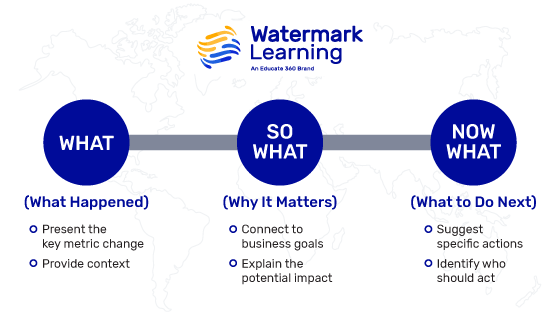Key Takeaways:
- Clarify Stakeholder Requests: BAs turn vague business needs into focused, data-driven questions.
- Translate Data into Action: Good storytelling connects the numbers to decisions teams can act on.
- Watch for Analysis Traps: Missteps, such as assuming causation or using small samples, can derail insights.
- Bridge Communication Gaps: Facilitation skills help BAs align goals across business and data teams.
- Build Process into Strategy: BAs bring structure that connects leadership, tools, and execution.
When Smart People Talk Past Each Other
At a mid-sized insurance company, the marketing team needed insights into customer churn. They asked for a “full report on customer behavior.” A week later, a 47-tab spreadsheet arrived. It was technically accurate but completely unhelpful. No commentary. No clear action. Marketers still didn’t know why customers were leaving.
The problem wasn’t the data quality or leadership. It was the translation. No one bridged the gap between business concerns and the data that could solve them. Business analysts (BAs) make all the difference in situations like this.
What does “translation” mean for a BA? It means turning business problems into data-driven questions and transforming data into insights people can understand and act on.
How Business Analysts Turn Stakeholder Requests into Data Questions
Translating business needs into clear data requests starts with understanding what the stakeholder really wants. Most requests are vague, rushed, or overly broad. Stakeholders rarely offer clean, specific questions. Instead, BAs often hear things like “Give me all the customer data” or “Show everything for Q2.”
It’s the BA’s job to diagnose the real issue with follow-up questions:
- What decision is this data supposed to support?
- What does success look like here?
- What’s the timeline, and who needs to act on this?
Turning Stakeholder Requests into Actionable Questions
Here’s a four-step approach BAs can use to translate vague requests into actionable questions.
Identify the Real Pain Point
- “Help me understand what’s driving this request.”
- Listen for emotional words: “frustrating,” “confusing,” “urgent”
Define Success Criteria
- “If this analysis is perfect, what decision will you make?”
- “Who else needs to act on this information?”
Set Boundaries
- “What timeframe are we looking at?”
- “Which customers/products/regions matter most?”
Test Your Translation
- Restate the request in your own words
- “Is this the core question we’re trying to answer?”
Before and After Examples
Original Request: “We need a report on web traffic.”
Translation Process:
- Pain point: “Conversion rates seem low, but we don’t know why.”
- Success criteria: “We want to optimize our marketing spend.”
- Boundaries: “Focus on the last 3 months, prioritize paid channels.”
- Confirmed Core Question: “Which marketing channels are driving the highest-quality traffic, and what’s causing visitors to drop off before converting?”
Red Flags to Watch For:
- Requests aimed at proving a pre-made point
- Asking for “everything” with no focus
- Ignoring known data limitations
- Phrases like “just run the numbers” or “make it look good”
Clarifying the ask ensures that the data you collect serves a purpose. But getting the correct data is only half the battle. The next step is turning that data into something teams can understand and use.
How Business Analysts Turn Data into Business Insights
Once data is analyzed, it’s the BA’s job to make sense of it. It’s not enough to report a churn rate or sales spike because those numbers need context, meaning, and an actionable path. The real value comes from helping stakeholders understand what the data says and what to do about it.
Let’s look at a quick example of the difference between reporting data and translating it into insight:
Raw data: “Customer churn rose 8%”
Translated data: “We’re losing new users after onboarding due to a confusing welcome email sequence.”
So how do BAs move from raw numbers to actionable insight? One proven method is the What – So What – Now What framework. It helps structure your analysis in a way that tells a clear, complete story:
The What – So What – Now What Framework
Using the What-So What-Now What framework enables you to take raw numbers and gain meaningful insights from them.
What Happened
- Present the key metric change
- Provide context
So What (Why It Matters)
- Connect to business goals
- Explain the potential impact
Now What (What to Do Next)
- Suggest specific actions
- Identify who should act

This framework transforms complex data into clear, actionable stories. But even the best storytelling falls apart if your analysis is flawed.
Example of Effective vs. Ineffective Metrics:
It’s important to remember that not all metrics are equal. Here’s a quick example of the difference between a vanity metric and one that drives action:
- Vanity metric: “Website traffic is up 20%.”
- Actionable metric: ” Trial signups from paid search rose 12%, likely due to updated landing page copy—47 more trials worth about $23,000 in potential revenue.”
Don’t expect perfect insights right away. Interpreting data is an iterative process. As teams explore insights, new questions will arise—and that’s a sign of progress.
Avoiding Common Data Interpretation Mistakes
Even strong analysis can backfire if it’s built on flawed assumptions. Mistakes like confusing correlation with causation or relying on tiny data sets lead to bad insights and erode trust. A great BA ensures patterns in the data are real, relevant, and responsibly interpreted. Here are the most common traps to avoid.
The Big Three Mistakes
1. Correlation vs. Causation: Don’t assume that because Y happened after X that X caused Y. Always ask what else changed.
2. Small Sample Sizes: Be cautious of misleading conclusions drawn from limited data. “Our new feature has a 50% adoption rate!” (based on 8 users)
3. Cherry-Picked Date Ranges: Use multiple periods and explain why you’re showing what you’re showing.
How to Recover from Analysis Mistakes
If you make a mistake, admit it, correct it, explain what went wrong, and add safeguards. Hiding errors destroys trust—being transparent builds it.
Transparency builds trust, even when you’re wrong. However, avoiding mistakes is only part of effective communication. The real challenge is helping different teams work together when they speak entirely different languages.
How Business Analysts Improve Communication Between Teams
Business analysts do more than interpret data. They help align people who think and speak differently. As facilitators, they create common ground to prevent miscommunication and wasted effort.
Advanced Facilitation Techniques
When teams define the same terms differently, good data can lead to bad decisions. These facilitation techniques help BAs surface misalignments early, ensuring projects start with a shared language, clear expectations, and fewer surprises.
- The Definition Workshop
- Use a definition workshop to uncover conflicting terminology—have stakeholders define key terms privately, then align on shared definitions as a group.
- The Expectation Alignment Meeting
- Ask stakeholders to share their ideal outcomes, resolve conflicts, and agree on success criteria in writing before the analysis begins.
- Managing Conflicting Stakeholder Definitions
- Use layered reporting when stakeholders define key metrics differently. Support both views while aligning on a shared baseline for decisions.
When team members define success differently, it’s up to the BA to surface those conflicts early and align the group. It’s not just about preventing arguments, it’s about laying the groundwork for data-driven decisions everyone can support. Once that work is done, one question remains: how do you know it’s working?
Why Business Analysts Are Essential to Turning Data Into Decisions
Everything we’ve covered so far, including translating requests, telling data stories, avoiding analysis traps, and bridging communication gaps, leads to one outcome: turning data into decisions that actually happen.
Measuring Your Translation Success
But how can you tell if your translation work is making an impact? Here are the signs to watch for in the short, medium, and long term.
Immediate Signs (Within 1-2 months):
- Stakeholders ask more specific questions
- Fewer requests for “everything” or “all the data”
- Data teams report clearer requirements
Medium-term Signs (3-6 months):
- Business decisions reference specific data points
- Stakeholders start challenging each other’s interpretations
- Teams use consistent terminology across departments
Long-term Signs (6+ months):
- Stakeholders proactively suggest data-driven solutions
- Business strategy discussions include data considerations
- Your role shifts from reactive to strategic
For example, at a global logistics company, managers clashed over which cost-cutting data to trust: shipment volume vs. fuel use. A business analyst stepped in, aligned success criteria, and reframed the analysis around “cost per delivery mile,” a metric both sides supported.
The result: faster decisions, less internal friction, and an 8% margin improvement in six months.
What Happens When Translation Fails
Consider this real scenario: A retail company’s BA provided weekly sales reports for six months. The reports were accurate, well-formatted, and delivered on time. But sales performance continued to decline. The problem? The BA shared data but not actions.
Stakeholders read the reports, nodded—and filed them away without knowing what to do.
This is why technical accuracy isn’t enough. You can be right about the data and still fail if you don’t help people understand how to use it effectively. The solution isn’t more data or better tools—it’s better translation.
Your Challenge: Become the Translator Your Organization Needs
You’ve seen how business analysts add value by turning vague requests into clear questions, linking insights to outcomes, and bridging the gap between business and data. These skills don’t appear overnight — they’re developed over time.
Whether you’re strengthening your own capabilities or developing a high-performing BA team, investing in translation skills is no longer optional. It’s what separates organizations that simply collect data from those that act on it.
At Watermark Learning, we help business analysts build these capabilities through training focused on frameworks, facilitation, and data storytelling. These are the skills that make insights meaningful and support truly informed decisions.
Not sure where to start? Reach out to Watermark Learning to explore which courses best fit your goals, your role, or your team’s needs.
Jay Pugh, PhD
Dr. Jay Pugh is an award-winning leader, author, and facilitator with over 18 years of teaching and training experience. Currently serving as Head of Leadership Growth at Educate 360, he leads a robust team of external and internal facilitators who specialize in developing leadership capabilities within medium and large-scale businesses. His team works directly with business professionals, helping them become more effective leaders in their daily operations.
Dr. Pugh holds a Ph.D. in Instructional Management and Leadership, and his academic contributions include two published articles and a dissertation focusing on various educational topics. His extensive experience and academic background have established him as a respected voice in leadership development and educational management.

 New Horizons
New Horizons
 Project Management Academy
Project Management Academy
 Six Sigma Online
Six Sigma Online
 Velopi
Velopi
 Watermark Learning
Watermark Learning
 Login
Login





 New Horizons
New Horizons
 Project Management Academy
Project Management Academy
 Velopi
Velopi
 Six Sigma Online
Six Sigma Online
 Watermark Learning
Watermark Learning